Critics often make their reputations by cruelly trashing a beloved restaurant, forcing their readers to attend to a snarling nitpicker all too pleased to demolish received wisdom. These are rabid eaters: their foam is not on the plate. If such is a reputational ploy, it is strategy on which I must pass in assessing Per Se. I march in lockstep with their clients, confessing that my taste buds lack the wisdom of venom.
My dinner at Per Se was the best meal that I have yet eaten in this culinary capital. I will go one step further, before taking a step back. This was my first meal where all complaints deserve to be in small print. My caution is that should some culinary accountant ask me to compose the half dozen best dishes of my New York months, I doubt if any single dish would quite make that list. (Pace Jimmy Frey, I am fond of that petit-déjeuner in the Yountville slammer). After so many dinners that don't quite measure up, I face a challenge: should I dine promiscuously, tickled by Daniel, Alain, Jean-Georges, and their peers, or should I choose Per Se tomorrow, Thursday, Easter, and forever. Am I in love or is this passing fancy?
I cannot claim to have eaten at the French Laundry (Hell, I can claim it, but not with thesmokinggun.com dogging my blog). When my wife and I had a dinner in Napa a decade ago, we had a sterling meal at Mustards Grill (who knew our options?). My dining companions had eaten with Tom Keller at the FL several times. For me, dinner at Per Se was a revelation: the back story of molecular cuisine. Keller is the missing link, the evolutionary connection, between Chez Panisse and Alinea (as infused by Ferran Adria). Others who have followed Keller's career can speak to his chain of innovation from the mandate of localism. The small courses, flavor clashes, and deconstructed dishes that now terrorize diners when in the wrong hands were all in evidence. (The meal was foam-free.) The difference was confidence. Chef Keller and his Per Se Chef de Cuisine Jonathan Benno are not experimenting on their diners; failures are in the disposal, not on the tasting menu. The fact that this was the Chef's Tasting Menu, reconceived each market day, made its gaffe-free quality astonishing. Further, these cooks know how to build a dinner. They are slightly too generous on their plates, but the meal demonstrated a harmonious progression. Chefs Keller and Benno have an agile ability to judge tastes and textures. Perhaps more surprising was that in almost every dish one ingredient, seemingly a side one, grabbed center stage, and proved to belong.
The molecular chefs of today are Keller's children (or at least his nephews). Having eaten at Charlie Trotter, I had given more weight to the Chicagoan in creating a Cuisine Agape, but Keller demands his share, a share that I shall no longer deny him. To understand Grant Achatz's triumphs at Alinea is to realize his inspired union of Trotter and Keller, adding his own fixation on aroma and emotion.
Surely Per Se is among the loveliest and calmest spaces in this bustling town. Every touch - the woods, stone, glass - was exquisitely chosen: Subtle, handsome, sumptuous, and restful. One might say that at this price it had better be, but Alain Ducasse, despite its pleasures, seems a bit dowdy in contrast. Per Se stands apart from restaurants that strive to push as many customers together: the Grateful Dead assumption that if we can no longer breathe, we must be having fun. Per Se is luxuriously filled with clean, still, quiet air.
The staff, who famously are no longer cadging for tips, were as congenial and professional as could be. Had the coat checker not grabbed my fedora by its crown, I would have had no complaints. These men and women actually seemed happy serving at Per Se, an attitude that might suggest to natives that they are overpaid, but probably only means that the despite the location in the Time-Warner Center, Ted Turner's management style has yet to infect the fourth floor.
We selected the Chef's Tasting Menu: Nine courses composed daily, plus a few extras. A reader is immediately snowed by an avalanche of quotation marks. All but one dish had something in quotation marks, in some cases as many as four. We were told that quotes were used around foreign ingredients ("tomme de brebis") and to indicate irony ("macaroni n' cheese" - and, since we are in Lynne Truss territory, isn't it "macaroni ‘n' cheese"?). Our menu novelist embraces the Condiment Theory of Punctuation: sprinkle marks liberally to bring out the flavor of the text. And while I have your attention, must every ingredient have a provenance? (This meal is sponsored by Cowart, Hallow, Four Story, and Hope Farms, each raising memories of Orwell's Manor Farm). I shiver that soon diners may be forced to watch a procession of marketing videos before the bread arrives. Just emblazon the napkins and be done with it.
Dinner begin with an amuse: a black sesame tuile filled with raw salmon perched on creme fraiche. Such an opening was surprising in not shocking. It was a subtle transformation of bagels and lox: not New York Sunday morning, but modified through a Napa dawn. The black pepper tuile, with its thin cookie crunch, made the amuse delightful. It was just different enough to emphasize that the chef was carefully calibrating tastes and textures.
Our opening course was the Per Se classic: "Oysters and Pearls": "Sabayon" of Pearl Tapioca with Island Creek Oysters and Russian Sevruga Caviar. With overfishing and Red Tide, we better scarf while we can. One imagines a taste profile when considering oysters and caviar: cool, slick, and just a bit fishy. But Chef Keller transformed this duo into a symphony of butter. I was startled at its grandeur, and that this richness did not seem cloying. The pearl tapioca provided an inspired echo of the sevruga, while soaking the butter, ready to explode. This dish not only deserves its repute, but deserves its quotation marks and deserves the Champagne that our sommelier suggested.
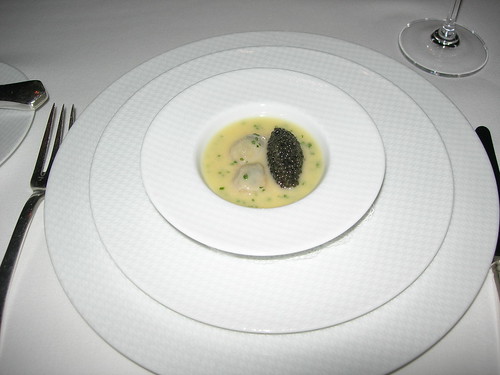
As a second course Per Se offers a choice: a foie gras terrine ($30 supplement to a $210 meal) or for those delicate of culinary politics a Vidalia onion salad (for truly delicate flowers a vegetable tasting menu is offered). I selected the Moulard Duck "Terrine de Foie Gras," with Quince "Jam," Marcona Almond "Crumble," Flowering Quince Relish and Frisée Lettuce with Toasted "Brioche." If truth be told my choice was a ballot for quince, a fruit whose presence in the United States is a side-benefit of immigration reform. The terrine was smooth, but no better than any competent spread (and rather a lot of it). But the quince transformed the somewhat unctuous organ with its bouncy acidity. The true hero of the plate was the "Brioche" - a slide of brioche, an idealized version of Paris, Texas Toast. I was grateful that, having consumed much of my first plate of toast, a server appeared with a second order (now briefly held in my larder). In the corner of the plate were a constellation of the tiniest droplets of a balsamic vinegar. The image was fetching, permitting a few bites with this divine Italian molasses.
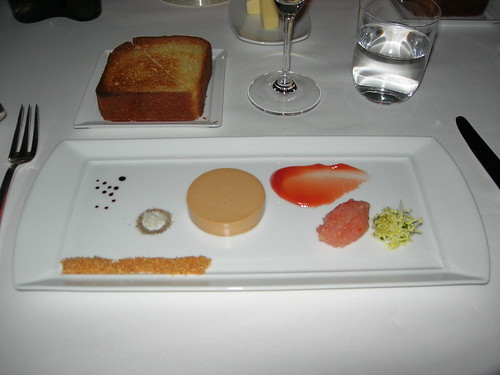
By the third course we were getting serious: Sautéed Fillet of Red Mullet (Rouget, a small redfish) with Lima Beans, Piquillo and Serrano Ham with Seville Orange-Roasted Garlic Emulsion. Such a dish pays tribute to (or perhaps inspired) the faddish trend of combining pork and fish: the oink ‘n' gill school of cuisine. The rouget was perfectly cooked. Not a moment overcooked, and the ham added a spicy note that the sweet fish lacked. Again the centerpiece was unexpected: lima beans. Lima beans are the Rodney Dangerfield of legumes, and until now, I felt such treatment was well-deserved. Chefs Keller and Benno upended my beanism. Lima beans with a crunch? Yikes! They were delicious and mediated between the rouget and serrano ham. The kitchen might have been more generous with the orange-garlic emulsion but given the spotty treatment of fish at some of New York's finest restaurants, I was enchanted.
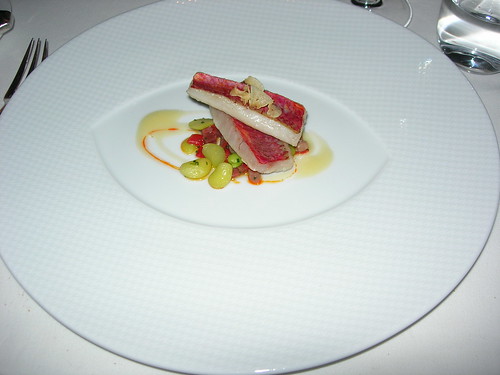
"Macaroni ‘n' Cheese" with Nova Scotia Lobster "Cuit Sous Vide," Parmesan "Crisp," Creamy Lobster Broth and Mascarpone-Enriched Orzo could not have been richer, even had there been a last-minute infusion of Devon cream and a dab of schmaltz. I offer myself as a medical subject to test whether flavor is enhanced through a sous vide technique (a boil in the bag without the boil): would a blind tasting reveal a difference with lobster plunged in a Down East stock pot? However cooked, the homard gave its life for this cuit cuisine. The orzo when consumed separately was rich for my taste, but in the mix, it did just fine. The star of the plate was the "crisp": a cheesy chip of which one truly could not just eat one, except one was all we were offered. Sigh.
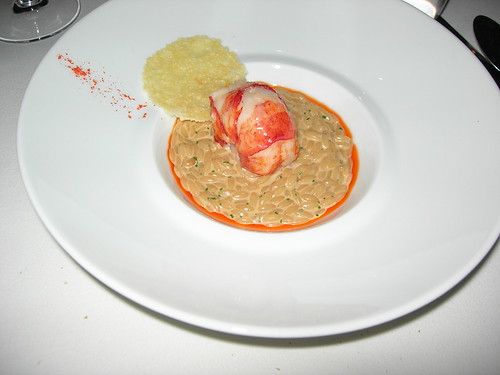
Our pair of meat dishes were rabbit and veal, selections somewhat lighter than usual, a match for a bottle of Chateauneuf du Pape. The rabbit was "Rillettes" of Hallow Farm's Rabbit with a "Ragoût of French Green Lentils, Celery Branch, Black Winter Truffles and Glazed Chestnuts. Of our dishes, I found this the least compelling. Served as a large brown marble, it had the taste of winter, somber, dusky, woodsy, nutty, and closed in. It was the dark heart of January cuisine. This dish was of the earth, not the heavens. I treasured the chestnuts and respected the soupy memories provoked by the green lentils, but I was soon ready for the veal.
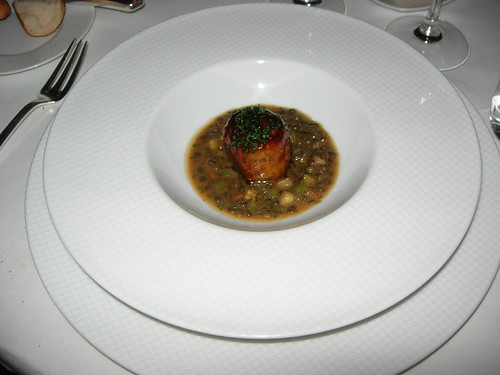
The veal, in contrast, flew by, no matter the cage in which its wrecked body may have been incarcerated. The menu describes this as Rib-Eye of Four Story Hill Farm's Nature Fed Veal with Black Trumpet Mushrooms, Thumbelina Carrots, Wilted Arrowleaf Spinach, and Red Pearl Potatoes with Veal "Jus." What the politics of "nature fed" might be the menu did not explain. Could it mean that Story Hill farmers did not feed the calf, an inspired marriage of cost-cutting and moralizing? (Soon to be the GOP child welfare policy.) Whatever. The upshot is that ‘ittle veal never became big ol' moo cow. Despite my speculations on the lifeworld of calves, I chose not to imagine wilted spinach, although I did glance down to see if mold was advertised. Despite my menu deconstruction, I enjoyed the large portion of veal, so much lighter than the rabbit. However, it was the trumpet mushrooms (black Chanterelles) that made this a treat for a winter night. Sometimes Per Se's dishes skirt the edge of complexity, but this was a simple, elegant preparation. Ignoring the adjectival arms race, the pinnacle of this dinner was simple veal, cooked in its own juices, with accompanying carrots, potatoes, mushrooms, and spinach. This is a canonical caress of perfect ingredients.
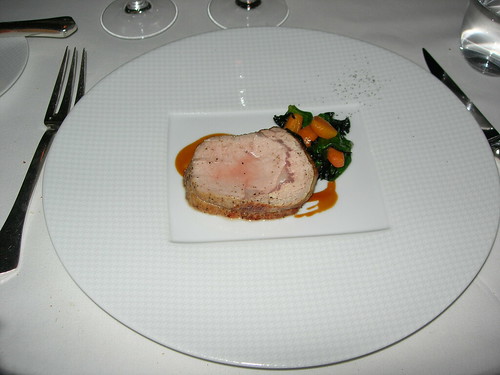
Feeling that we might be a bit peckish at this point, cheese was on the agenda: Hope Farm's "Tomme de Brebis" with Corn Bread, "Julienne" of Granny Smith Apple and Bourbon-Maple Apple Butter. Tomme de Brebis is an Auvergne sheep milk cheese. One of my dining companions recalled it as a semi-soft cheese, but this was made of firmer stuff, a slightly sharp-sweet cheese, but one that was upstaged by the splendid apple butter, slightly liquored up and waiting for the sap to run. It was a lovely mix with the corn bread, the apple, and the cheese, permitting us to choose how to mix these options. Like the veal, this was a fundamentally simple dish, but one that deserved its placement on the menu.
Our first dessert was Hayden Mango Sorbet with Braised Pineapple, Black Sesame "Nougatine" and Passion Fruit Syrup. While my sorbet was pungent and intense, it had a few stray bits of ice. But what amazed more than the sorbet was the strip of braised pineapple, looking all the word like a strip of fruity hamachi. One edge must have been dipped in a syrup (perhaps the above named passion fruit syrup). It was opulent and lush, and captured our hearts. A third in a sequence of simple tributes to excellence.
Although the final dish on the Chef's Tasting Menu was a deconstructed version of "S'mores", I requested a chocolate-free closer: Sweet Garden Carrot Cake with Cream Cheese Icing, Candied Walnut "Crust," Black Raisin "Coulis" and Indonesian Cinnamon Ice Cream. With all those quotations, one knows that this too was an exercise in literary theory. It was once said that in contrast to cooks, bakers were chemists, today they are English majors. My wife makes a Platonic carrot cake, filled with rough-cut carrots and nuts, and I remain loyal to her inspirations. These cake bites were carrot flour and air, not farmstead sweets. Still, if one didn't mind eating a bite of this and a bite of that, this was a canny and sensuous dessert. (Per Se's pastry chef is Sébastien Rouxel). It reminded me of Sam Mason's desserts, more of what the best young pastry chefs do in their sleep. I was breathless at the microscopic carrot off to the corner, a mini-micro carrot cooked in orange juice, a lilliputian lagniappe placed as if to announce that "we will do anything to amaze."
The final extra (before the mignardises) was a yogurt pot-de-creme with Quince Marmalade. I have admitted my partiality for quince, admitting it to our server, and I wondered whether the kitchen made this smooth treat for "me" (quotations intended).
Being a French Laundry virgin (and a virgin at Bouchon and Bouchon Las Vegas, TK's Nevada food-porn palace), I can't claim experience in affairs de Keller. However, every life must have its start. What amazed me was less the treatment of the main ingredient, but the preparation of those that surrounded it. When I recall this meal, it will be through visions of quince, chestnuts, lima beans, Parmesan crisps, pineapple, and toast and butter. At the great restaurants, it is not doing the big things right, but doing the tiniest things astonishingly: a carrot that belongs in the halls of Ripley's Believe it or Not.
Per Se
10 Columbus Circle (at 60th Street and 8th Avenue, 4th Floor)
Manhattan (Time-Warner Center)
212-823-9335

No comments:
Post a Comment